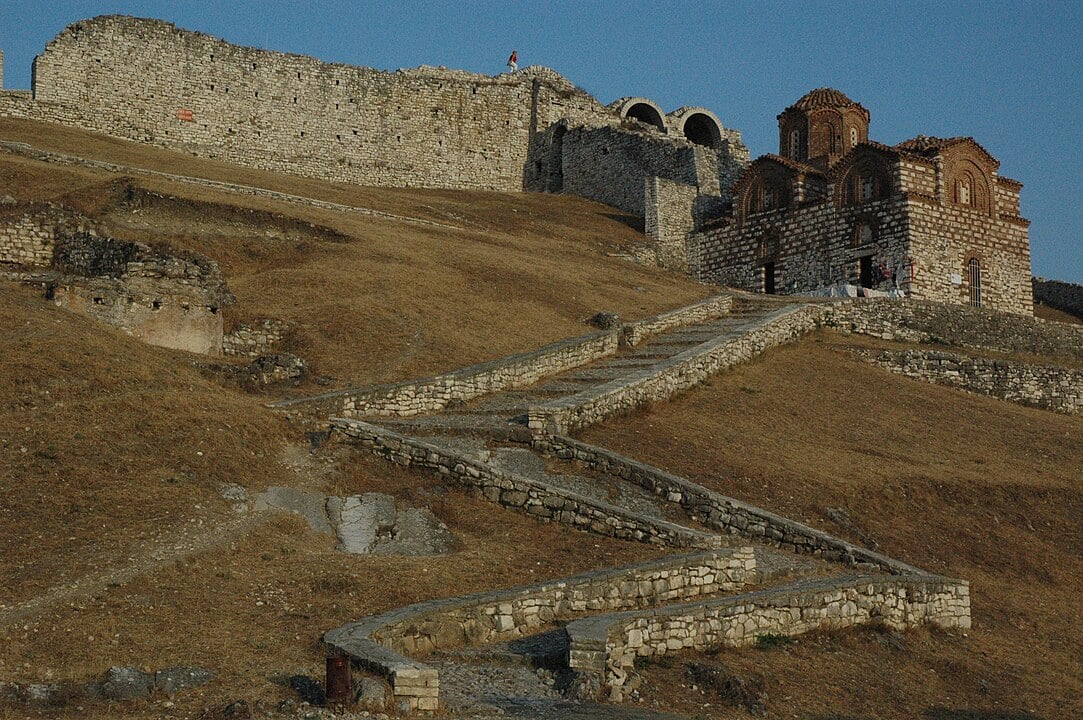Two mosaic floors uncovered in Berat, Albania, once known as ancient Antipatrea (Greek: Ἀντιπάτρεια), are shedding light on its early Christian past and its strong links to the Greek-speaking world of late antiquity.
The mosaic floors uncovered in recent years offer rare evidence from a period often hidden by centuries of rebuilding. Researchers say these findings help clarify how Christian life developed in a city shaped by both local traditions and broader Greek cultural influences.
The first mosaic was uncovered in 2012 during infrastructure work inside Berat’s medieval castle. The second appeared in 2018 in the lower town, beneath later Ottoman-era buildings. Both mosaics contribute important data to the archaeological record of Antipatrea, where early Christian structures are difficult to trace due to later construction that destroyed much of the original landscape.
The mosaic found inside the castle survives in a fragment of about 20 square meters. It features geometric borders, interlaced patterns, and inscriptions written in Greek letters. Archaeologists believe the floor once belonged to a late antique basilica, though the full layout of the structure has not yet been uncovered.
Made from limestone and terracotta tesserae, the mosaic includes octagonal grids, ivy scrolls, and interlaced bands. These motifs appear widely across the Balkans and the Adriatic but also show clear continuity with Greek artistic vocabulary.
Researchers say the decorative program fits well within the visual language used in Greek-speaking Christian communities during the late antique period.
The second mosaic is smaller but holds a key detail. Its inscription includes the word Theotokos, a title for Mary that was formally endorsed at the Council of Ephesus in 431, one of the major church councils of the Greek-speaking Eastern Roman Empire.
New discoveries in ancient Antipatrea (modern Berat, #Albania) reveal two late antique mosaics with Greek inscriptions — including Theotokos from the 431 Council of Ephesus.#Archaeology #History #Greece #Balkans pic.twitter.com/ToXuAkp1w1
— Tom Marvolo Riddle (@tom_riddle2025) November 17, 2025
The use of this term provides a firm date after the council and shows that Antipatrea was closely aligned with theological developments shaped within the Greek Christian world.
Researchers say the inscription demonstrates that the Christian community in ancient Antipatrea followed doctrinal language circulating across the Aegean and eastern Mediterranean. It also indicates that Berat was not isolated but participated in broader religious networks tied to Greek liturgical and theological traditions.
Comparative studies show that the mosaics’ designs appear in major late antique centers such as Bylis, Butrint, Stobi, and Heraclea Lyncestis—all regions strongly influenced by Greek culture, language, and administration.
The shared motifs suggest that mosaic workshops moved across these areas, spreading techniques and contributing to a common artistic style that linked Albania with the Hellenized Balkans. The consistent use of local limestone and terracotta points to regional workshops, but the designs themselves reflect artistic exchange that extended into Greek cultural zones.
While modern Berat is best known for its Ottoman-era cityscape, these mosaics reveal older layers tied to the Greek history of Antipatrea. The city’s ancient name, Greek inscriptions, and Greek Christian terminology highlight a long-standing cultural connection that shaped its late antique identity.
Experts say the discoveries underscore the need for more systematic archaeological investigation. Additional work, they note, could further clarify how early Christian communities in this ancient Greek-founded city lived, worshipped, and interacted with wider networks across the Balkans and the Aegean world.
See all the latest news from Greece and the world at Greekreporter.com. Contact our newsroom to report an update or send your story, photos and videos. Follow GR on Google News and subscribe here to our daily email!
© Copyright – GreekReporter.com
